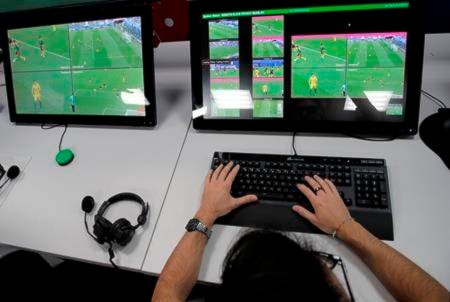KRASNOGORSK, Russia — Two cramped rooms in a Moscow suburb could make or break countries’ dreams of World Cup glory.
This World Cup tournament will be the first to use video reviews, standard practice in many other sports around the world, but an abomination to some football fans who see it as killing the game’s soul.
Deep in the bowels of FIFA’s International Broadcast Center, just outside the Moscow city limits, are two rooms decorated in blue-and-red World Cup branding. Along each wall are places for four Video Assistant Referees and 15 screens capable of showing 33 camera angles. It’s all ready for the first World Cup game to use the VAR system on Thursday when Russia plays Saudi Arabia.
FIFA hopes VAR will stop fans griping about biased, incompetent or corrupt referees — even though in the last two weeks, one Saudi referee was dropped from the World Cup after being banned for life in a corruption case, while a Kenyan assistant referee stepped down from World Cup duties after being filmed apparently accepting a cash payment.
“I don’t need to wait for VAR to guarantee people that referees are honest,” said Massimo Busacca, head of FIFA’s refereeing department, during a tour of the facilities Saturday. “Everyone watching the situation can even have another confirmation that the decision was correct, so they cannot complain any more. Believe me, even without VAR, we have to believe in what referees are doing.”
Referees, four to a game, will sit in office chairs along one wall with monitor operators trained to find the best camera angles for a disputed penalty or offside call.
One is the chief Video Assistant Referee, making the final calls. He — all the World Cup officials are male — is backed up by one assistant specializing in offside, another who checks his colleagues’ work for errors, and one who keeps an eye on the live TV feed while the others are deliberating.
Technology in soccer remains in its infancy compared to tennis or American football.
Beside the lavish GameDay Central video suite used by the NFL, FIFA’s version is modest. With myriad plasma screens, more officials and smarter decor, the NFL version looks like a cross between a luxury hotel lobby and a competition for pro computer gamers.
VAR’s first high-profile rollout at last year’s Confederations Cup was plagued with problems.
After Eduardo Vargas put the ball in the net for Chile against Cameroon, the celebrations meant many players and fans in Moscow’s Spartak Stadium didn’t notice referee Damir Skomina making the gesture for a video review.
There was no word over the PA system or on the big screens for a few minutes as fans tried to grasp what was going on. Players milled about, some heading for the dressing room before realizing it wasn’t yet halftime. Eventually Skomina received the VAR decision — offside — and Vargas’ goal was disallowed, a tournament first.
FIFA says it’s worked on improving communications.
“There will be graphics in the stadium and after the referee’s decision also images, so the idea is to be totally transparent,” said Robert Rosetti, an Italian former referee now overseeing VAR’s rollout for FIFA.
Last month’s Champions League final didn’t use VAR, but if it had, a key incident might have been viewed differently.
Liverpool goalkeeper Loris Karius clashed heavily with Real Madrid and Spain’s Sergio Ramos shortly before making a crucial mistake which resulted in Real scoring. He was later diagnosed by one hospital with concussion. Few noticed the clash at the time, but since Ramos seemed to make contact with Karius’ head, a VAR system could have reviewed the incident as a potential red-card offence.
Another Ramos tackle, which left Liverpool’s Mohamed Salah with a shoulder injury, would be unlikely to be reviewed since it didn’t appear to be a potential red-card offence or goal-scoring opportunity.
Rosetti said VAR will make the World Cup fairer, even if video reviews break up the flow of the game. VAR would catch an offence like Diego Maradona’s “Hand of God” handball against England at the 1986 World Cup quarterfinals, Rosetti suggested.
“The target of VAR is justice,” he said. “I don’t know if we want a goal scored by hand in the last minute of the final of the World Cup. This can kill football, not a good intervention from technology.”
